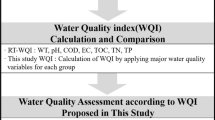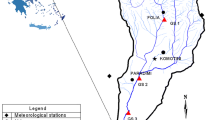Abstract
The Danjiangkou Reservoir is the water source for the middle route of the South-to-North Water Diversion Project in China. Thus, its water quality status is of great concern. Five water quality indicators (dissolved oxygen, permanganate index, ammonia nitrogen, total nitrogen, and total phosphorus), were measured at three monitoring sites (the Danjiangkou Reservoir dam, the Hejiawan and the Jiangbei bridge), to investigate changing trends, and spatiotemporal characteristics of water quality in the Danjiangkou Reservoir area from January 2006 to May 2012. We then applied a Bayesian statistical method to evaluate the water quality comprehensively. The normal distribution sampling method was used to calculate likelihood, and the entropy weight method was used to determine indicator weights for variables of interest in to the study. The results indicated that concentrations of all five indicators increased during the last six years. In addition, the water quality in the reservoir was worse during the wet season (from May to October), than during the dry season (from November to April of the next year). Overall, the probability of the water’s belonging to quality category of type II, according to environmental quality standards for surface water in China, was 27.7%–33.7%, larger than that of its belonging to the other four water quality types. The increasing concentrations of nutrients could result in eutrophication of the Danjiangkou Reservoir. This method reduced the subjectivity that is commonly associated with determining indicator weights and artificial classifications, achieving more reliable results. These results indicate that it is important for the interbasin water diversion project to implement integrated water quality management in the Danjiangkou Reservoir area.
Similar content being viewed by others
References
Cai Y P, Huang G H, Tan Q, Chen B (2011). Identification of optimal strategies for improving eco-resilience to floods in ecologically vulnerable regions of a wetland. Ecol Model, 222(2): 360–369
Cha Y K, Stow C A, Reckhow K H, DeMarchi C, Johengen T H (2010). Phosphorus load estimation in the Saginaw River, MI using a Bayesian hierarchical/multilevel model. Water Res, 44(10): 3270–3282
Chen S Z, Wang X J, Zhao X J (2008). An attribute recognition model based on entropy weight for evaluating the quality of groundwater sources. Journal of China University of Mining and Technology, 18(1): 72–75
Chib S (1996). Calculating posterior distributions and modal estimates in Markov mixture models. J Econom, 75(1): 79–97
Debels P, Figueroa R, Urrutia R, Barra R, Niell X (2005). Evaluation of water quality in the Chillán River (Central Chile) using physicochemical parameters and a modified water quality index. Environ Monit Assess, 110(1–3): 301–322
Ip W C, Hu B Q, Wong H, Xia J (2009). Applications of grey relational method to river environment quality evaluation in China. J Hydrol (Amst), 379(3–4): 284–290
Jensen F V (1996). An Introduction to Bayesian Networks (Vol. 210). London: UCL Press
Jiang B Q, Wang W S, Wen X C (2007). An improved BP neural networks model on water quality evaluation. Computer Systems Applications, 9: 46–50 (in Chinese)
Jin J L, Huang H M, Wei Y M (2004). Comprehensive evaluation model for water quality based on combined weights. Journal of Hydroelectric Engineering, 23(3): 13–19 (in Chinese)
Jun K S, Chung E S, Sung J Y, Lee K S (2011). Development of spatial water resources vulnerability index considering climate change impacts. Sci Total Environ, 409(24): 5228–5242
Li S Y, Cheng X L, Xu Z F, Han H Y, Zhang Q F (2009a). Spatial and temporal patterns of the water quality in the Danjiangkou Reservoir, China. Hydrol Sci J, 54(1): 124–134
Li S Y, Gu S, Liu W Z, Han H Y, Zhang Q F (2008). Water quality in relation to the land use and land cover in the Upper Han River Basin, China. Catena, 75(2): 216–222
Li S Y, Liu W Z, Gu S, Cheng X L, Xu Z F, Zhang Q F (2009b). Spatiotemporal dynamics of nutrients in the upper Han River basin, China. J Hazard Mater, 162(2–3): 1340–1346
Liao J, Wang J Y, Ding J (2009).Water quality assessment of main rivers in Sichuan based on improved Bayes model. Journal of Sichuan Normal University (Natural Science), 32(4): 518–521 (in Chinese)
Liu L, Zhou J Z, An X L, Zhang Y C, Yang L (2010). Using fuzzy theory and information entropy for water quality assessment in Three Gorges region, China. Expert Syst Appl, 37(3): 2517–2521
Ni S H, Bai Y H (2000). Application of BP neural network model in groundwater quality evaluation. Systems Engineering Theory and Practice, 20(8): 124–127 (in Chinese)
Parinet B, Lhote A, Legube B (2004). Principal component analysis: an appropriate tool for water quality evaluation and management-application to a tropical lake system. Ecol Model, 178(3–4): 295–311
Qian S S, Reckhow K H (2007). Combining model results and monitoring data for water quality assessment. Environ Sci Technol, 41(14): 5008–5013
Qian S S, Schulman A, Koplos J, Kotros A, Kellar P (2004). A hierarchical modeling approach for estimating national distributions of chemicals in public drinking water systems. Environ Sci Technol, 38(4): 1176–1182
Schoen M E, Small M J, Vanbriesen J M (2010). Bayesian model for flow-class dependent distributions of fecal-indicator bacterial concentration in surface waters. Water Res, 44(3): 1006–1016
Tan Q, Huang G H, Cai Y P (2011). Radial interval chance-constained programming for agricultural non-proint source water pollution control under unceitainty. Agricultural Water Management, 98(10): 1595–1606
Unnikrishnan N K (2010). Bayesian analysis for outliers in survey sampling. Comput Stat Data Anal, 54(8): 1962–1974
Wu H Y, Chen K L, Chen Z H, Chen Q H, Qiu Y P, Wu J C, Zhang J F (2012). Evaluation for the ecological quality status of coastal waters in East China Sea using fuzzy integrated assessment method. Mar Pollut Bull, 64(3): 546–555
Wu R, Qian S S, Hao F H, Cheng H G, Zhu D S, Zhang J Y (2011). Modeling contaminant concentration distributions in China’s centralized source waters. Environ Sci Technol, 45(14): 6041–6048
Xing S L, Zhang Z F, Tian R, Yang L P (2011). Evaluation of underground water quality in Qingshuihe District, Inner Mongolia Autonomous Region. Procedia Environmental Sciences, 11(Part C): 1434–1440
Yin K H, Yuan H R, Ruan Y, Li Z Y (2001). Variation and correlation of environmental parameters in the water of Danjiangkou Reservoir. Resources and Environment in the Yangtze Basin, 10(1): 81–87 (in Chinese)
Zhang Q F, Xu Z F, Shen Z H, Li S Y, Wang S S (2009). The Han River watershed management initiative for the South-to-North Water Transfer project (Middle Route) of China. Environ Monit Assess, 148(1–4): 369–377
Zhao Y, Nan J, Cui F Y, Guo L (2007). Water quality forecast through application of BP neural network at Yuqiao reservoir. Journal of Zhejiang University SCIENCE A, 8(9): 1482–1487
Zou Z H, Yun Y, Sun J N (2006). Entropy method for determination of weight of evaluating indicators in fuzzy synthetic evaluation for water quality assessment. J Environ Sci (China), 18(5): 1020–1023
Author information
Authors and Affiliations
Corresponding author
Rights and permissions
About this article
Cite this article
Ma, F., Li, C., Wang, X. et al. A Bayesian method for comprehensive water quality evaluation of the Danjiangkou Reservoir water source area, for the middle route of the South-to-North Water Diversion Project in China. Front. Earth Sci. 8, 242–250 (2014). https://doi.org/10.1007/s11707-013-0395-6
Received:
Accepted:
Published:
Issue Date:
DOI: https://doi.org/10.1007/s11707-013-0395-6




